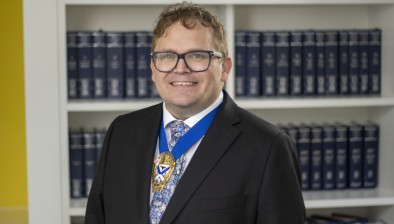Ken Dalling: At last – an increase in Scottish legal aid fees

Ken Dalling
Ken Dalling, principal of Dalling Solicitors in Stirling and a member of both the Council and the Board of the Law Society of Scotland, writes on today’s three per cent increase in fees for legal aid lawyers.
So here we are. At long last we have arrived at a day which, frankly, I had given up all hope of seeing. A day when legal aid rates are increased.
Without wishing to detract from the good work of Alison Atack, the current President of the Law Society, and her immediate forebears I am rather inclined to the view that the current Cabinet Secretary Humsa Yousaf and his colleague Ash Denham, when looking at the numbers, were inevitably of the view that to ignore the need for action would be not only politically unjustifiable but personally embarrassing.
There was once a link between legal aid rates and the payment that solicitors could expect from fee paying clients. A link but nothing like parity. The profession acknowledged that the “certainty of payment” and with a third party paying for the client’s case a healthy discount would apply. The legal aid rates were however to be kept under review. Until 1992 that was. Not merely last century, but 27 years ago, that all stopped.
I was a young solicitor in 1992, just about to establish my own firm. I remember colleagues commenting on the courage that it required to commit to the ever increasing overhead of premises and staff in the context of a legal aid funding model. Little did I know that more than two decades later I would be operating in an economic environment that, so far as legal aid income was concerned, hadn’t improved.
Of course there have been changes before today’s three per cent increase but they have meant little. The move to fixed or block payments in both civil and criminal cases was supposed to make things easier for the solicitor and to reduce administration for the Scottish Legal Aid Board. In civil cases the blocks often mask the detail of work that is required in difficult cases and by demanding clients (or their opponents) and in criminal cases the disposal fee in summary cases, which rewarded the solicitor for resolving a case early, was as of nothing compared to the system savings that it created. The reinvestment of such savings into the legal aid spend, which had been promised to the profession, did not materialise. For solemn crime, prosecuted before a jury in the Sheriff and High Courts, the supposed increase in fees which arrived with peer review was more promised than real; rather than look at revisiting the rates to be sure that the increase had been achieved, the solemn fees were firstly cut so as to share funding across unfunded areas and subsequently criminal fee cuts were agreed in terms of austerity and to protect against the wholesale roll out of the Public Defence Solicitor. And, bearing in mind the eagerness of SLAB to abate solicitors accounts as well as the strict(ly short) time limits for submitting accounts, the concept of certainty of payment is not exactly bankable.
Today the base legal aid rate for work carried out by a solicitor (travel) will increase from £21.10 per hour to £21.76 (£24.20 to £25.16 in solemn cases). Office work increases from £42.20 to £43.48 (£48.80 to £50.28 in solemn cases) and advocacy from £54.80 to £56.46 (£73.20 to £75.40 in solemn cases). In the rare instances when a non solicitor member of staff carries out chargeable work they generate income at an average of about £24 per hour - unless they are taking a witness statement in a solemn case when it is £11.90 per hour. And remember these aren’t the rates of pay that the staff member receives, they are contributions to firm turnover from which overheads must be met before the firm’s partners can share any profit. The three per cent increase still leaves the profession 106.5% behind in real terms. So by RPI alone, and without any weighting for the increases in the technical or evidential difficulty of cases across almost 30 years, those rates should be more than double the “new” rates.
The Scottish Government has, however, promised more than just the three per cent increase and a working party has been established to decide how, in future, the rates will be reviewed. But here’s an idea - unless there is a real willingness to let the profession catch up on lost ground, why not just commit to annual increase in line with inflation? Something which has in fact applied to the charge rates of Sheriff Officers. Wouldn’t that save a lot of time and trouble? And if my scepticism about the will to repair the funding shortfall is misplaced, I could be proved wrong simply by the Government reversing the cuts of 2011.
The truth is that government funding for those who cannot themselves pay for a solicitor is a necessary condition to maintaining access to justice and the rule of law. It is essential in a civilised society. Funding of legal aid is not a cost to society it is an investment in our society and one which pays a substantial dividend. The time has passed when it can be expected that privately funded work can appropriately subsidise the legal aid sector. I can only hope that is now being recognised.

- Ken Dalling is the principal of Dalling Solicitors in Stirling and a member of both the Council and the Board of the Law Society of Scotland.








